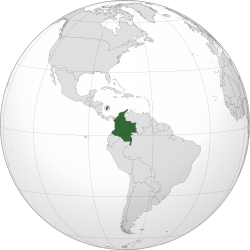FAIR and interactive data graphics from a scientific knowledge graph
Kaonekelo
| Republic of Colombia |
||||||
|---|---|---|---|---|---|---|
|
||||||
| Chiluso: "Libertad y Orden" (Spanish) ("Freedom and Order") |
||||||
| Nyimbo: Himno Nacional de la República de Colombia (Spanish) ("National Anthem of the Republic of Colombia") |
||||||
 Makhalilo gha Colombia (dark green) in South America (grey) Makhalilo gha Colombia (dark green) in South America (grey) |
||||||
| Msumba Waboma kweneso Msumba Usani | Bogotá | |||||
| Chiyowoyelo chaboma | Spanish | |||||
| Recognized vyakumanyikwa vyamuvigaŵa | English (in San Andrés and Providencia) 64 other languages[a] |
|||||
| Mitundu ya Ŵanthu (2018 census[1]) |
|
|||||
| Vipembezo |
|
|||||
| Mwenecharu | Colombian | |||||
| Mtundu wa Boma | Unitary presidential republic | |||||
| - | President | Gustavo Petro | ||||
| - | Vice President | Francia Márquez | ||||
| - | Upper house | Senate | ||||
| - | Lower house | Chamber of Representatives | ||||
| Independence from Spain | ||||||
| - | Declared | 20 July 1810 | ||||
| - | Recognized | 7 August 1819 | ||||
| - | Last unitarisation | 1886 | ||||
| - | Secession of Panama | 1903 | ||||
| - | Current Constitution | 4 July 1991 | ||||
| Ukulu wa Malo | ||||||
| - | Malo | 1,141,748 km2 (25th) 440,831 sq mi |
||||
| - | Maji (%) | 2.1 (as of 2015)[2] | ||||
| Chiŵelengelo cha ŵanthu | ||||||
| - | 2022 estimate | 52,156,254[3] (27th) | ||||
| - | Density | 42.23/km2 (173rd) 105.72/sq mi |
||||
| GDP (PPP) | 2022 estimate | |||||
| - | Total | |||||
| - | Per capita | |||||
| GDP (nominal) | 2022 estimate | |||||
| - | Total | |||||
| - | Per capita | |||||
| Gini (2020) | high |
|||||
| HDI (2021) | high ·88th |
|||||
| Ndalama | Colombian peso (COP) |
|||||
| Mtundu Wanyengo | COT (UTC−5[b]) | |||||
| Kalembelo kasiku | dd-mm-yyyy (CE) | |||||
| Woko la galimoto | right | |||||
| Intaneti yacharu | .co | |||||
| a. | ^ Although the Colombian Constitution specifies Spanish (Castellano) as the official language in all Colombian territory, other languages spoken in the country by ethnic groups – approximately 68 languages – each is also official in its own territory.[7] English is also official in the archipelago of San Andrés, Providencia and Santa Catalina.[8] | |||||
| b. | ^ The official Colombian time[9] is controlled and coordinated by the National Institute of Metrology.[10] | |||||
Colombia, ni chalo icho chili kwa Amelika wa Kummwela.
- ↑ Longola ivyo vyabudika: Invalid
<ref>tag; no text was provided for refs namedgrupos étnicos - ↑ "Surface water and surface water change". Organisation for Economic Co-operation and Development (OECD). Retrieved 11 October 2020.
- ↑ "Proyecciones de Población DANE". National Administrative Department of Statistics (Colombia). Retrieved 28 October 2022.
- ↑ 4.0 4.1 4.2 4.3 "World Economic Outlook Database: Colombia". International Monetary Fund. April 2022. Retrieved 21 April 2022.
- ↑ "GINI index (World Bank estimate) – Colombia". World Bank. Retrieved 19 June 2021.
- ↑ "Human Development Report 2021/2022" (PDF) (in English). United Nations Development Programme. 8 September 2022. Archived (PDF) from the original on 2022-10-09. Retrieved 8 September 2022.
- ↑ Colombian Constitution of 1991 (Title I – Concerning Fundamental Principles – Article 10)
- ↑ "LEY 47 DE 1993" (in Spanish). alcaldiabogota.gov.co. Retrieved 23 February 2014.
- ↑ "The official Colombian time" (in Spanish). horalegal.inm.gov.co. Retrieved 23 February 2014.
- ↑ "Decreto 4175 de 2011, artículo 6, numeral 14" (in Spanish). Presidencia de la República de Colombia. Retrieved 14 March 2016.




















